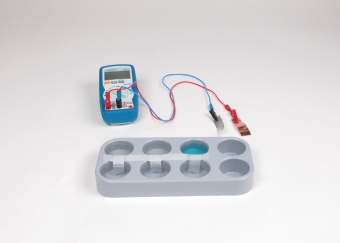Principle
Different voltages are generated between various metals when they are combined in galvanic cells. These voltages are the quantitative expression of the potential differences between the two half-cells connected together. The greater the tendency of a metal to go into solution, the further the equilibrium of such a redox process lies to the right. As it is not possible to measure the tendency to go into solution, i.e. the potential of a metal, alone in one half- cell, it cannot be given a definite order of magnitude. However, the differences between the potentials of various metals are measurable when they are connected in galvanic cells. This opens up the possibility of giving each metal (and other redox couples also) a relative potential value by coupling it in a galvanic cell with a reference electrode which is always the same.
Learning objectives
- Principle of an standard hydrogen electrode
- How to measure differnce of potentials with reference electrodes
Benefits
- Easy teaching and efficient learning by using interactive experimentation PHYWE-Software
- Experiment is part of a complete solution set with experiments for the topic Electrochemistry matched with international curriculum: all topics are covered



